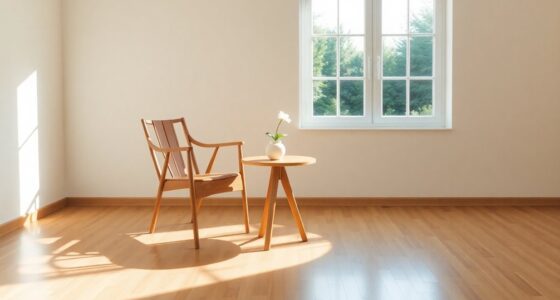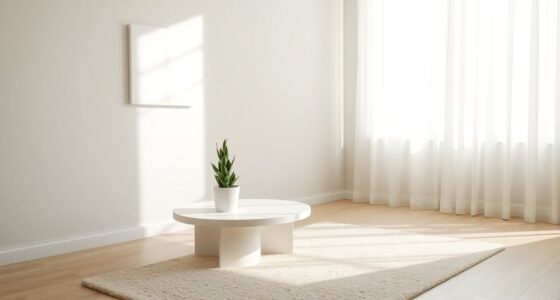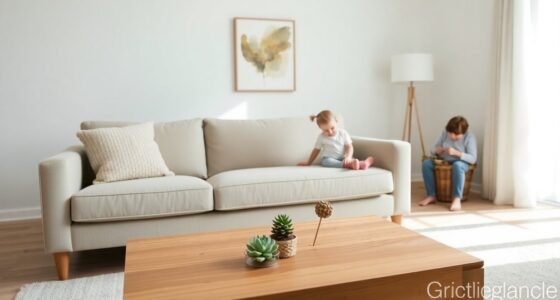Clutter can weigh you down, increasing anxiety and hindering your focus. By embracing a minimalist approach, you'll start seeing a transformation in your space and mindset. Focus on decluttering first—removing what doesn't serve you before organizing what's left. Use practical methods like the 4-box system and consider what truly sparks joy. Simple storage solutions can help maintain order, making your home a calm oasis. Discover how to sustain this peaceful environment and more effective strategies ahead.
Key Takeaways
- Start by decluttering, removing unnecessary items to create a calm environment that enhances relaxation and focus.
- Use the Marie Kondo method to evaluate belongings based on joy, purpose, and usage.
- Implement the 4-box method (Keep, Donate/Sell, Garbage/Recycling) to efficiently sort through items.
- Establish designated zones for items and utilize clear storage solutions for easy categorization and access.
- Regularly reassess your organized spaces and involve family in maintaining a clutter-free home for ongoing success.
Understanding the Impact of Clutter on Your Life
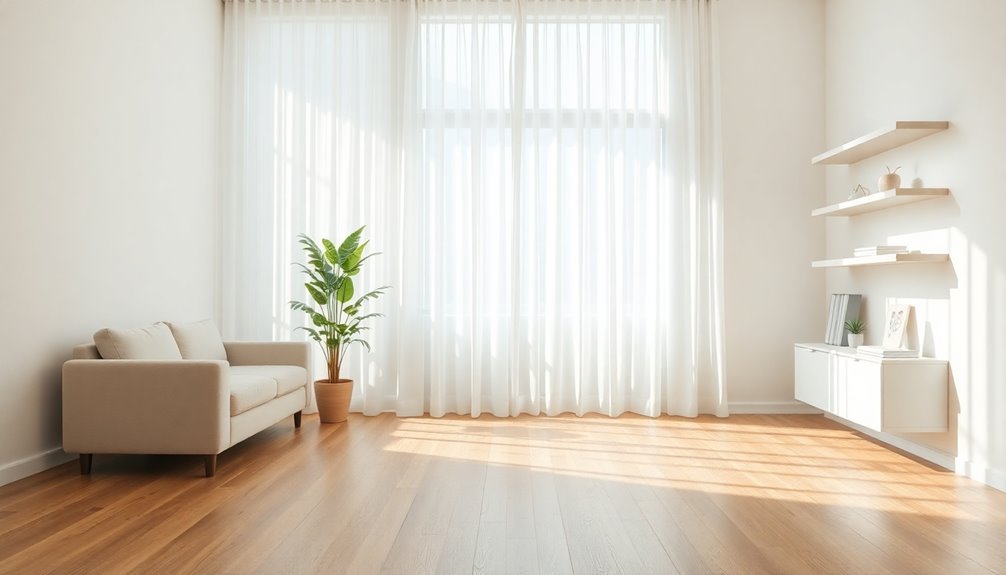
When you're surrounded by clutter, it's easy to feel overwhelmed and anxious, which can take a toll on your mental health. Clutter not only increases feelings of frustration but also makes it tough to maintain organization in your living space.
You might find that emotional attachments to unused items hinder your personal growth and distract you from pursuing meaningful experiences. By choosing to declutter, you can transform your environment, leading to a more relaxed state of mind.
Research shows that a clutter-free space promotes focus and allows you to prioritize what truly matters. When you decide to organize your home, you shift your mindset, valuing experiences over possessions, ultimately enhancing your overall life satisfaction. Additionally, maintaining a high vibrational energy can lead to a more fulfilling decluttering process and promote relaxation before sleep for better manifestations.
The Difference Between Decluttering and Organizing
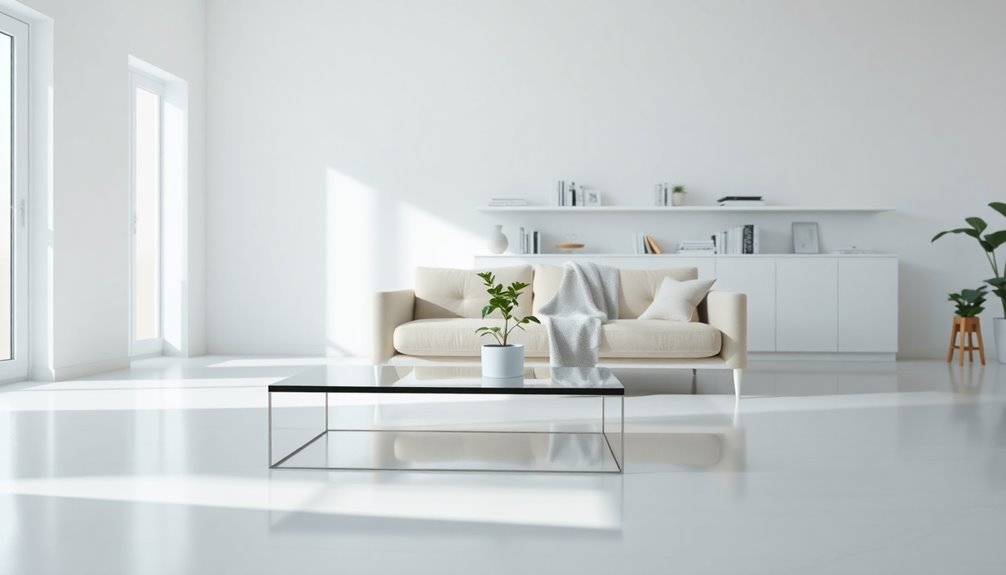
While many people use the terms "decluttering" and "organizing" interchangeably, they represent two distinct processes.
Decluttering involves removing unnecessary items from your home, while organizing focuses on arranging the remaining items logically and accessibly.
Decluttering means clearing out what's unnecessary, while organizing is about smartly arranging what you keep.
If you start with organizing before decluttering, you might end up keeping items you no longer need, as this approach doesn't tackle the root cause of clutter.
A clutter-free environment simplifies organizing, making it easier to maintain designated spaces for essential items.
Remember, effective decluttering is vital for achieving a truly organized home; simply rearranging clutter won't solve disorganization issues. Additionally, embracing intentional living can further enhance your journey towards a minimalist lifestyle.
Identifying Essentials: What to Keep and What to Let Go

To identify what to keep and what to let go, start by evaluating the value of each item in your home.
Consider whether it brings you joy, serves a purpose, or is used regularly, as this helps reveal emotional attachments that may cloud your judgment.
Prioritizing functional necessities will make your space more organized and enjoyable. Additionally, incorporating essential oils for relaxation can enhance your home's atmosphere and promote a calming environment while you declutter.
Assessing Item Value
How do you determine what truly matters in your home? Start by evaluating item value through three simple criteria: whether you like it, need it, or use it regularly. This helps you identify emotional clutter and prioritize essentials. Consider using the Marie Kondo method—ask if it sparks joy or serves a necessary function. Don't let guilt cloud your choices; evaluate how items contribute to your life goals. Implement the 4-box method for a streamlined approach:
| Keep | Donate/Sell | Garbage/Recycling |
|---|---|---|
| Essentials | Unused | Broken or Damaged |
| Joyful | Duplicates | Outdated |
| Functional | Seasonal | Unwanted Gifts |
| Loved | Extras | Non-functional |
Taking photos of items before letting go can ease the emotional burden. Additionally, remember that effective preparation can significantly enhance your decision-making process during this decluttering journey.
Emotional Attachments Unveiled
Emotional attachments often complicate the decluttering journey, making it hard to decide what to keep and what to let go. You might find yourself holding onto items out of guilt or nostalgia rather than necessity.
To navigate this, consider:
- What do you genuinely like and use?
- Does the item spark joy, as Marie Kondo suggests?
- Can you document your journey to track progress?
Engaging in reflective questioning about your possessions can help you release guilt and shame. Additionally, creating a serene environment with non-toxic XL houseplants can enhance your space and promote a sense of calm as you declutter.
Prioritizing Functional Necessities
When you're decluttering your home, prioritizing functional necessities is essential for creating a space that truly supports your lifestyle.
Start by evaluating each item: ask yourself if it's essential for daily living, used regularly, or if it sparks joy. Channel your inner Marie Kondo during this process.
Identify and eliminate unitaskers—those items that take up space but serve only one purpose. Keep only what genuinely helps you achieve your life goals.
Holding onto items out of guilt can clutter both your space and your mind. Regularly revisit your belongings to maintain a minimalist approach, ensuring your home remains organized and peaceful.
Focus on what truly matters, and let go of the rest. Additionally, consider investing in best home security systems to enhance your peace of mind while enjoying your newly organized space.
Steps to Declutter Your Space Effectively
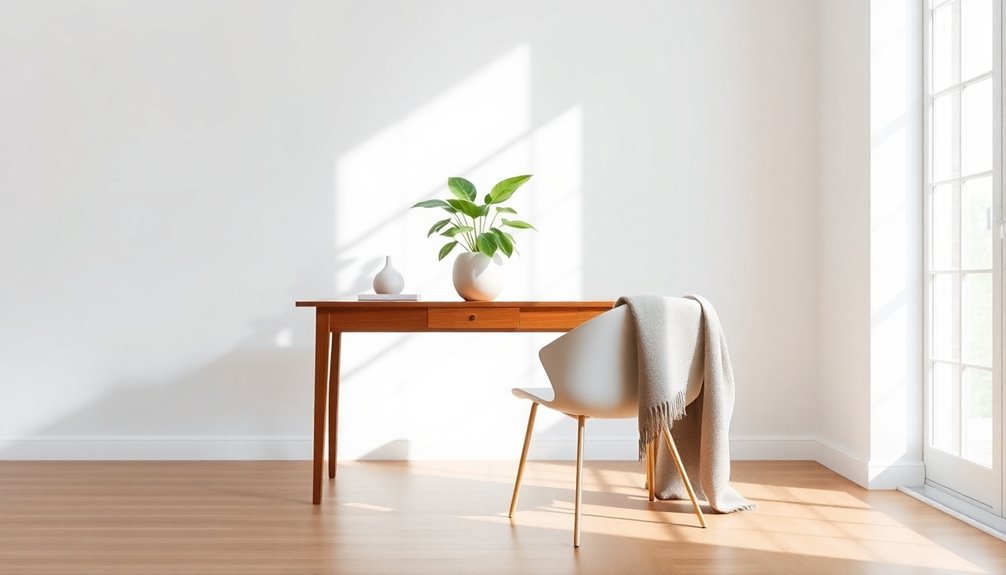
Decluttering your space can feel overwhelming, but you can tackle it in just five effective steps. Start small with areas like your junk drawer to achieve quick wins and boost motivation.
- Use the 4-box method: donate/sell, garbage, recycling, and keep.
- Ask yourself if each item is liked, needed, or used regularly.
- Apply the PENALTY BOX tactic for indecisive items, letting them sit for a while before making a decision.
Once you've sorted, promptly remove decluttered items to maintain momentum. This immediate action will help you avoid donation pile stagnation, leading to a clearer and calmer living space.
In addition, embracing the minimalist way can enhance your overall well-being and create a more peaceful environment.
Embrace these steps, and you'll find it easier to declutter and create a more peaceful environment.
Organizing After Decluttering: Creating Functional Spaces
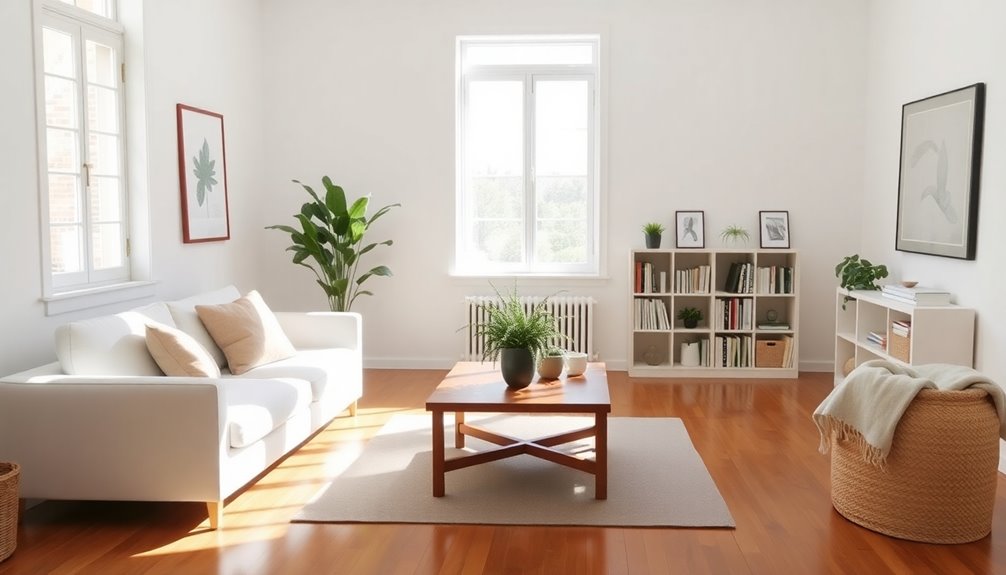
After you've successfully decluttered your space, the next step is to organize it in a way that enhances functionality.
Start by focusing on one room or drawer at a time, creating designated zones based on how you use items. This approach promotes efficiency and accessibility.
Implement simple organizing systems that everyone in your home can understand, ensuring consistency.
Utilize storage solutions like clear bins and natural material baskets to categorize items, adding visual appeal to your environment.
Don't forget to create a designated drop-off area for daily essentials like keys and bags to streamline your routines.
Regularly reassess these organized spaces to keep them clutter-free, maintaining order and ensuring your home remains functional. Additionally, consider incorporating vertical storage solutions to free up floor space and optimize your organization efforts.
Maintaining a Clutter-Free Home: Tips and Strategies
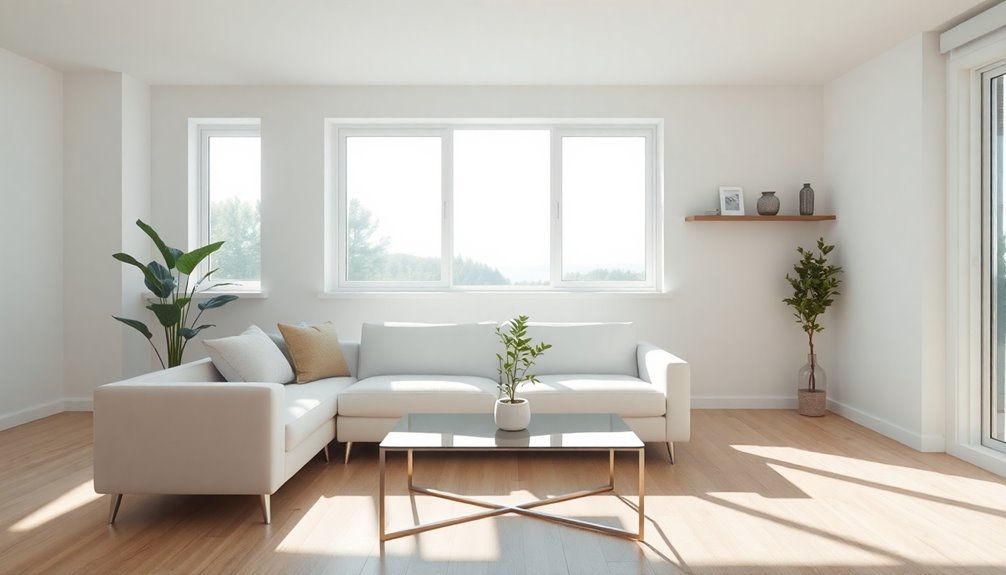
To maintain a clutter-free home, start by setting up designated storage solutions that give every item a specific place. Regularly reassessing your belongings through a decluttering schedule will help you stay on top of what you truly need. Additionally, investing in high-quality brewing capabilities can enhance your daily routine and minimize clutter by providing a dedicated coffee station instead of multiple appliances.
Designated Storage Solutions
Creating a clutter-free home starts with designated storage solutions that guarantee everything has its own place. By implementing these strategies, you'll enhance organization and keep your space tidy:
- Use clear bins and labeled boxes for easy identification of items.
- Create a designated drop-off area for everyday essentials like keys and bags.
- Opt for cohesive storage solutions, such as uniform containers in your pantry.
These designated storage solutions not only streamline your daily routine but also reduce the temptation to dump items randomly. Incorporating clear bins can help you easily identify and access your belongings, promoting a more organized environment.
Regularly reassessing your storage systems based on usage patterns will help you maintain a clutter-free environment.
With these tips, you can foster ongoing organization and enjoy a calm, serene home.
Regular Decluttering Schedule
While it might seem intimidating, establishing a regular decluttering schedule can transform your home into a serene space free of clutter. Set aside specific times each week or month to assess your living room and other areas.
Use the 4-box method—designate boxes for keep, donate/sell, garbage, and recycling—to simplify the sorting process. Implement the "one in, one out" rule: for every new item you bring home, declutter an equivalent item.
Regularly evaluate high-traffic zones to prevent clutter buildup, ensuring your daily routines remain smooth. Encourage everyone in your household to join in, assigning them specific areas to manage.
This collective effort fosters a commitment to maintaining a clutter-free environment, making your home a calm oasis.
Resources and Community Support for Your Decluttering Journey
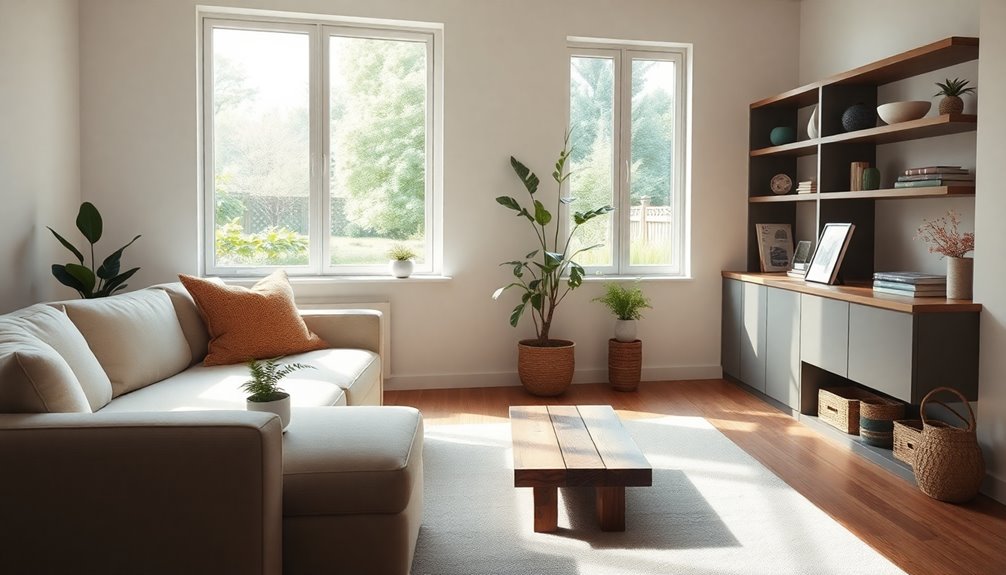
Finding support can make all the difference in your decluttering journey, as connecting with others who share similar goals often boosts motivation and accountability.
One great resource is the Nourishing Minimalism Facebook group, where you'll find a vibrant community dedicated to minimalism. Here, you can share experiences, gain insights, and learn from others.
- Access personal stories that inspire your decluttering efforts.
- Discover practical tips for organizing various spaces, from kitchens to garages.
- Engage in discussions that foster collaborative problem-solving.
With this community support and resources at your fingertips, you'll feel empowered to tackle clutter, maintain an organized home, and embrace a minimalist lifestyle.
Don't hesitate to reach out and connect!
Frequently Asked Questions
How to Go From Cluttered to Minimalist?
To go from cluttered to minimalist, start by identifying items that truly enhance your life and let go of those you feel obligated to keep.
Tackle small areas first, like a junk drawer, to build momentum. Use the 4-box method to categorize belongings and make decisions easier.
For indecisive items, try the penalty box technique.
Finally, establish designated zones for your essentials to maintain a clean, organized, and calming environment.
What Is the 12-12-12 Rule for Decluttering?
Think of decluttering like pruning a garden; it helps your space flourish.
The 12-12-12 rule simplifies this process. You'll find 12 items to donate, throw away, or relocate, making it manageable.
It's a focused approach that prevents overwhelm while encouraging you to be mindful about your possessions.
What Is the 30/30 Rule for Minimalists?
The 30/30 Rule for minimalists is a practical guideline to help you declutter.
If you can replace an item for $30 or less and it takes you 30 minutes or less to do so, consider letting it go.
This rule encourages you to evaluate the true value of your possessions based on cost and time, making decision-making easier and promoting a more streamlined living space focused on experiences instead of clutter.
What Is the 90-90 Rule for Minimalism?
The 90-90 Rule for minimalism suggests that if you haven't used something in the last 90 days and don't expect to use it in the next 90 days, it's probably time to let it go.
This rule helps you assess your belongings based on practical use rather than emotional attachment.
Conclusion
Embrace the calm that comes with a clutter-free home. Let go of the unnecessary, cherish the essentials, and create spaces that inspire you. Simplify your surroundings, organize your life, and maintain your newfound serenity. With each step you take, you'll find clarity, enjoy peace, and experience freedom. Remember, it's not just about the stuff you keep; it's about the joy you cultivate. Start today, and transform your space into a haven of tranquility.


